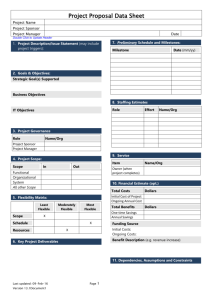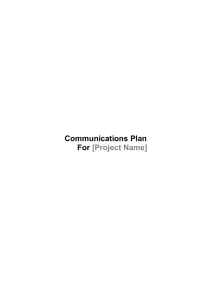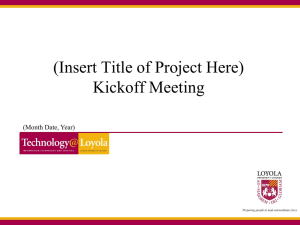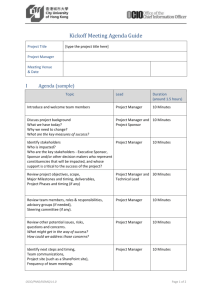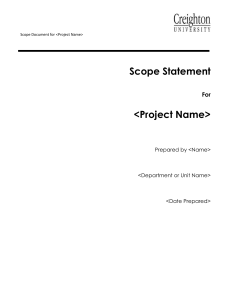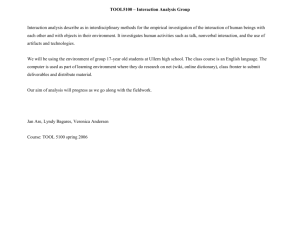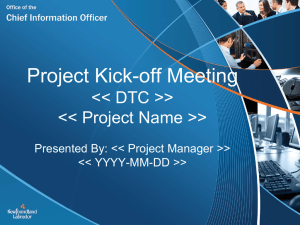ITS Project Management Methodology
advertisement
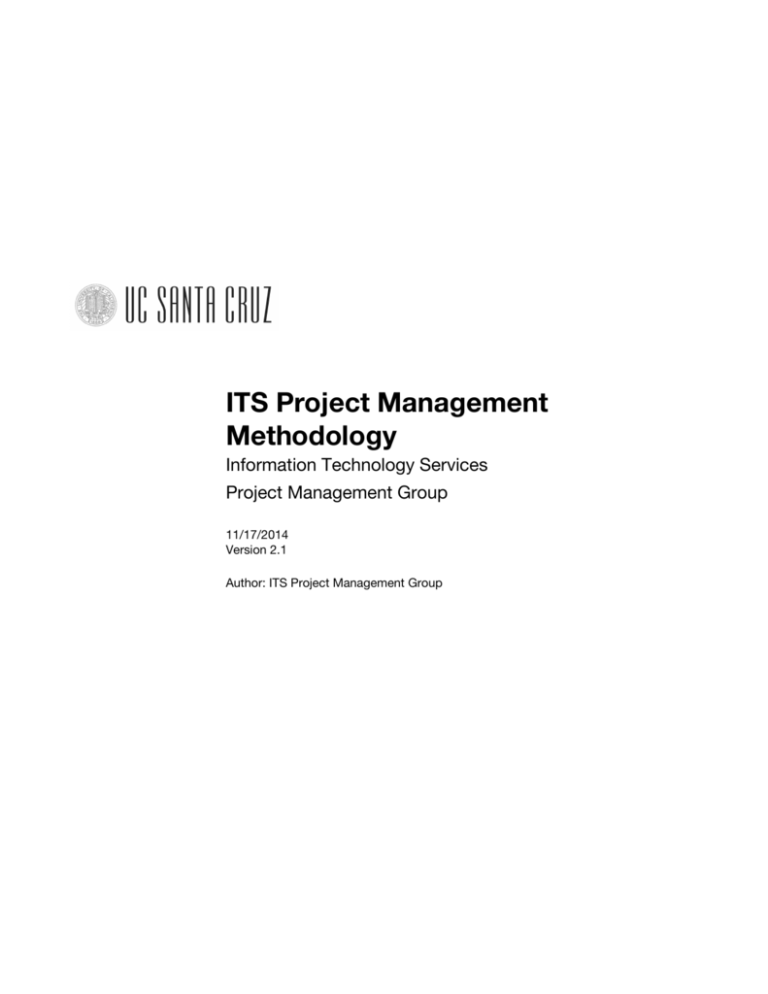
ITS Project Management Methodology Information Technology Services Project Management Group 11/17/2014 Version 2.1 Author: ITS Project Management Group Document Control Change Record Date Author Version Change Reference 8/5/200 9 Marion Bashista 2.0 Major revisions and rearranged content; added change management, activities, and outputs and deliverables; revised Requirements Matrix 10/2/09 Marion Bashista 2.0 Updated per David Turner’s review. 2/16/12 Marion Bashista 2.1 Updated process per revised process flow approved by SMT Reviewers Sign Off Date Reviewer Position Sign Off Distribution Copy Number Name Table of Contents 1 BACKGROUND 2 DEFINITIONS 3 4 2.1 Problem/Opportunities 2.2 Project 2.3 Project Management 2.4 Program 2.5 Program Management 2.6 Portfolio Management PROJECT CLASSIFICATION 3.1 Why Do We Classify? 3.2 How Do We Classify? 3.3 Considering the Project Size Matrix 3.4 Considering the Project Risk Matrix PROJECT MANAGEMENT METHODOLOGY 4.1 4.2 4.3 4.4 4.5 Define 4.1.1 Activities 4.1.2 Outputs and Deliverables Plan 4.2.1 Activities 4.2.2 Outputs and Deliverables Launch 4.3.1 Activities 4.3.2 Outputs and Deliverables Manage 4.4.1 Activities 4.4.2 Outputs and Deliverables Close 4.5.1 Activities 4.5.2 Outputs and Deliverables 5 PROJECT CLASSIFICATION-METHODOLOGY REQUIREMENTS MATRIX 6 PROJECT INITIATION PROCESS FLOW 7 STANDARD ROLES AND RESPONSIBILITIES 8 7.1 Executive Sponsor (Class 4/5 Project) 7.2 Executive Committee (Class 4/5 Project) 7.3 Steering Committee 7.4 Program/Project Sponsor 7.5 Program/Project Manager 7.6 Team Lead 7.7 Team Member 7.8 Application Designer 7.9 Application Developer 7.10 Business Analyst 7.11 Customers 7.12 Stakeholders GLOSSARY 1 Background This ITS Project Management Methodology document provides Information Technology Services (ITS) project teams with a set of standards to initiate and manage individual projects. The Methodology provides tools to make the project manager’s job a little easier. It contains definitions, guidelines, and templates for the various project management activities needed to deliver successful projects. The Methodology establishes common ground for all projects within UCSC ITS. The ITS project management methodology development process was guided by the following objectives: ▪ The design should seek to be reasonable, comprehensive, flexible, and accessible. ▪ The content will enforce discipline but not disallow application of a project manager’s critical judgment and insight. The standards in this Methodology serve as assets to each ITS project manager and team, and provide a common format for evaluating progress toward project goals, objectives, and deliverables. The Methodology encourages a top-down approach to project management. It ties directly to the project life cycle phases and provides a more precise definition of projects, a common lexicon used in project management, and a framework of activities mapped to each project class size. The ITS Project Management Group (PMG) built the Project Management Methodology, a customized project management methodology, to enable ITS project managers to focus on those processes that bring value. This methodology: ▪ Provides a common language for communicating and planning prior to the start of the project work. ▪ Encourages appropriate communication and planning prior to the start of project work ▪ Establishes a means for managing projects more efficiently ▪ Enables the tracking of progress against pre-determined metrics and facilitates standardized reporting. ▪ Leads to effective project outcomes which achieve institutional objectives ▪ Builds on a set of best practices learned over time. The long-term intent is to build a project management repository to document best practices, lessons learned, and examples of various documents that may be developed during a project. The UCSC ITS Project Management Methodology is an adaptation of the project management methodology described in Effective Project Management: Traditional, Adaptive, Extreme, 3rd Edition, by Robert Wysocki and Rudd McGary, and published by John Wiley & Sons in 2003. 2 Definitions Project methodology makes assumptions about the use of specific terms and project management issues. This section defines some of the key terms and differentiates their use. Specific project roles are defined in Section 4—Standard Roles and Responsibilities. 2.1 Problem/Opportunities Problem/opportunities are those campus IT endeavors vetted and communicated beyond the boundaries of the organization. They are those efforts that meet any of the following conditions: ▪ Have an impact beyond the division sponsoring the effort (e.g. changes or creates a new process or a procedure or function) ▪ Create benefits beyond the sponsoring division ▪ Initiate a partnership with an external stakeholder (e.g. Regulatory requirements) ▪ Influence or are influenced by strategic planning ▪ Require resources external to the unit/organization to successfully complete the problem/opportunities Through the process of program and project structuring each campus problem/opportunities may develop into programs or a set of projects for implementation. 2.2 Project A project is group of related work activities organized under the direction of a project manager which, when carried out, will achieve specified objectives within a stated timeframe. A project has a defined scope, deliverables or outcomes, work steps, duration, and budget as defined in a Project Charter. A project ▪ Is temporary with a distinct beginning and end ▪ Is a minimum of 80 hours ▪ Is defined by specific deliverables ▪ Is conducted by a temporary team that exists for its execution ▪ Has a single project manager who is responsible for its success ▪ Is defined by identifying the starting point, the goal/objectives, and the route between them 2.3 Project Management Project management defines managing single projects that meet the following general guidelines: ▪ The project has a logical scope. ▪ Duration is typically from 3 months to 5 years. ▪ Team size is typically less than eight members including the project manager. ▪ There is a single project sponsor. ▪ There is a single project manager. 2.4 Program A Program is a group of related projects that address a common business goal or problem/opportunities. Individual projects comprising a program are interdependent and must be successfully completed for the business program to meet its objectives. Programs provide a means of organizing and managing large, complex, or longer-term project efforts. The overall effort is subdivided into a set of small interdependent projects, each of which implements some portion of the overall solution. 2.5 Program Management Program management is the means by which multiple projects are managed to achieve a common strategic business goal or objective. Program management may be applied to any opportunity too large to address with a single project. 2.6 Portfolio Management Portfolio Management is the process by which a set of campus problem/opportunities are identified, evaluated, ranked, matched to available funding, and approved for implementation. It requires consultation and close collaboration of the IT function, clients and key executive stakeholders, and sponsors. Portfolio management is a key governance process for the activities of the IT function. The goal of portfolio management is maximization of the total value realized by the implementation of a set of proposed problem/opportunities given finite funding and resources. Portfolio management must be tightly integrated with program and project management so that problem/opportunities can be properly scoped, estimated, and structured into programs and projects. 3 Project Classification The Methodology is not a one-size-fits-all methodology. Rather it is an approach that specifies the processes used to manage a project based on its characteristics. Those characteristics are defined so that classes of projects are formed and so that each class has its own specification as to which parts of the Methodology are appropriate. 3.1 Why Do We Classify? The amount of documentation and required project management activities should scale to size of each project. This approach is strongly advocated as it adapts the methodology to the project. The value of the characteristics are used to determine which parts of the project management methodology must be used and which parts are left to the discretion of the project manager to use as he or she sees fit. In the final analysis, defer to the judgment of the project manager. Apart from those required by the organization, the project manager should adopt whatever parts of the methodology he or she feels will improve their ability to help successfully manage the project. 3.2 How Do We Classify? All projects can be classified into a project class based on the amount of work effort and risk. A small project would fall into Class 1 while a very large project would fall into Class 5. The amount of documentation and required project management activities scales to size of each project. Classification is a two-step process. ▪ First, using the Project Classification – Sizing Matrix, the initial class of the project is determined. ▪ The second step uses the Project Risk Matrix as a ‘modifier’ of the project’s initial class to determine the actual class. 3.3 Considering the Project Size Matrix Project class is initially determined based on work effort represented by the estimated duration (not number of person-hours) required to complete the work. Table 3.1 - ITS Project Classification Sizing Matrix 3.4 Considering the Project Risk Matrix Although work effort is a good indicator for the amount of project management that should be expended, certain factors can also bring about the need for the application of more robust project management practices. The Risk Matrix identifies six risk factors to be evaluated once the initial classification level is determined. In the event that the total risk score is greater than 10, the classification level should be increased. Table 3.2 - ITS Project Classification Risk Matrix 4 Project Management Methodology A project management methodology is a: ▪ Conceptual framework for program and project management ▪ Set of guidelines, standards and processes It is an evolving vehicle for sharing and communicating lessons learned and best practices for program and project management. The purpose of a project management methodology is to: ▪ Provide project managers and teams advice and guidelines to deliver better and consistent project results ▪ Provide a common language and framework describing programs, projects and the practice of project management ▪ Provide project managers a means of sharing and leveraging experience, lessons learned, and best practices. The methodology described here is intended to be a starting point for the project manager to think about structure and manage their projects. It is a work in progress. It is the PMG teams’ intention that this methodology will be augmented and refined over time by the collective experience at UC Santa Cruz. The methodology outlined here is a synthesis of current practices on the campus and specific methodologies employed by consulting firms and other organizations worldwide. To simplify the design and execution of campus projects, this methodology is comprised of five project management phases. Figure Number 1 Project Management Phases Each phase addresses a specific aspect of managing a project from define through close. Although these phases are described sequentially in practice, some may overlap or be applied concurrently. The results of each phase are described by a set of project management deliverables or artifacts. These artifacts provide visibility to application of the methodology and clear communication to project stakeholders. Each of these phases and deliverables are described in more detail in the sections that follow. Define 4.1 The first phase of the project management life cycle is the define phase. This phase is the one most often given the least attention. The define phase scopes the project. When a project is in the early phases an initial high level Project Proposal should be created. This allows the project sponsor and project manager to quickly understand the dimensions of the project and identify alternate approaches. At this phase, the process is exploratory in nature and it is not always certain that the project will proceed. It is not advisable to spend too much effort on scoping the project. A rough order of magnitude estimate of project resources (costs, FTE’s) and schedule will suffice for moving the project through the first phase of the project management process. 4.1.1 Activities Once the initial definition of the project is complete, it is documented in the form of the Project Proposal. The Project Proposal is a brief document (usually one page) that describes, in the language of the business, the following. ▪ What is the problem or opportunity to be addressed by the project? ▪ What are the projects’ goal and objectives? ▪ How will success be measured? ▪ What is the high-level budget and timeline for the project? ▪ What assumptions, risks, and obstacles may affect the project that you wish to call to the attention of senior management? At this point, a “Go/No Go” decision is made by the project sponsor and an ITS Manager, for class 1 and 2 projects, or ITS Senior Management Team (SMT), for class 3 and larger projects. ○ If the project is approved at this phase, it moves to the next phase, Plan where the project charter is developed. ○ If the project is not approved for further consideration then the reasons for not approving it and the initial project charter serve as a record of the governance process. 4.1.2 Outputs and Deliverables Outputs and deliverables from the Define phase of the project management life cycle are: ▪ Sponsor approval ▪ ITS Manager approval (small projects) ▪ ITS Director approval (large projects) ▪ Completed Project Proposal 4.2 Plan This second phase of the project management life cycle focuses on scoping and planning the project. Details about the project are determined, including an estimated timeline and budget. These details are captured in the complete Project Charter. The Project Charter is used to provide greater clarity on the scope of the project and how the objectives will be achieved. The Project Charter also documents the agreement between the project manager and the project sponsor for a successful project completion. 4.2.1 Activities Using documents produced in the define phase, the project manager, core team and key client representatives develop a detailed project plan. The plan defines the time, cost, and resource requirements needed to deliver the functionality identified in the define phase. Key questions that need to be answered in this phase are: ▪ Why is the program or project needed? (Objectives) ▪ What outputs or results will the project need to produce? (Deliverables and Outcomes) ▪ How long will the project take and what people and roles will be needed to execute it? (Workplan) ▪ What are the project costs and benefits? ▪ How will risks be managed? ▪ What are the detailed resources (costs, FTE) required? The Project Charter is refined to identify specific resources and roles, approach, deliverables and a work plan. In addition, a project risk assessment should be developed. A risk assessment identifies potential risks and defines the appropriate risk mitigation strategies. The risk assessment may result in changes in the project scope, timing, role assignments, and cost. The Project Charter should be updated reflecting this new information. Once the more detailed Project Charter has been developed, the project will be subject to a second “Go/No Go” decision by the project sponsors and the IT Portfolio Management governance process. If the project is approved on this second iteration, resources will be assigned and the project will be launched. During the Plan phase, a temporary project manager may be assigned to work with the sponsor(s) to develop the Project Charter, project plan and risk assessment. Once the project is approved for mobilization, the final project manager assignment will be made. For governance reasons and for practical purposes the project charter is developed in an iterative manner. Two “Go/No Go” decision points are included in the Plan phase to move the project from concept to launch. 4.2.2 Outputs and Deliverables Outputs and deliverables from the Plan phase of the project management life cycle are: ▪ Sponsor approval ▪ ITS Manager approval (small projects) ▪ ITS SMT approval (large projects) ▪ Completed Project Charter ▪ Completed Project Budget ▪ Assigned and approved project staff resources ▪ Analysis of APM User Interface Standards 4.3 Launch At this phase, a specific project governance structure is established (Executive Sponsor, Project Sponsor, Steering Committee etc.). The project organization is finalized. Project team members are cast in their roles and briefed on the project by the assigned project manager. The project team members refine the project work plan as necessary and are assigned responsibility for their specific tasks and deliverables. The figure below shows a typical project organization structure. The roles in the diagram are described in the Standard Roles and Responsibilities section. Figure Number 2 Typical Project Organization The project manager leads and coaches the team to achieve the goals of the project. The project manager works collaboratively with the Project sponsor to guide the efforts, update the plan, resolve project issues, and to obtain key business decisions when necessary. During this phase, the project issue log is a key tool to capture issues and their resolution. An issue is a formally defined matter that may impede progress of a project or a program for which no agreement has been reached. The project issue log tracks issues and key decisions. 4.3.1 ▪ ▪ ▪ Activities Project kick-off meeting Team assignments Assess and review project plan 4.3.2 ▪ ▪ Outputs and Deliverables Resource requirements Issues and risks logs 4.4 Manage The Manage Phase of a project includes all of the tasks that the project manager and team must do in order to keep the work of the project moving along as planned. This phase runs throughout the life of the project to keep stakeholders informed and to engage their active involvement and sponsorship for the project or program. Reporting project status is a critical success factor at this phase for managing expectations of project sponsors, the project steering committee, and other key stakeholders. Regular and effective reporting is critical synchronization of multiple projects within a program. The two aspects to communications in this phase are internal and external project communication and formal or informal communication. ○ Formal reporting may be sponsor or committee briefings, presentations, or written reports. ○ Informal reporting can be minutes, “management by walking around”, or sponsor and team discussions. Formal external reporting to Steering Committees and Executives should be built into the project calendar. This allows time for preparation and alignment with the end of major project phases or the key milestones. Project manager/project sponsor meetings should focus on ▪ resolving issues ▪ reviewing deliverables and work products ▪ project milestone progress For formal internal reporting, standing meetings should be established for the project team and the project sponsor and project manager. The frequency of these meetings should be appropriate to the duration of the project. At minimum, these should be weekly meetings. Project team meetings should focus on ▪ reviewing task progress from the previous period ▪ reviewing tasks for the next period ▪ reviewing the issue log Meetings of the project team, project manager/sponsor should be scheduled to give project team a sense of the larger context of the project and to enable interaction between the project sponsor and the whole team. This interaction is important from a collaboration perspective and provides an opportunity for the project sponsor to demonstrate their interest and active sponsorship in the project. A regular and appropriate reporting mechanism for the project can be a fine balancing act. Over- or under-communicating leads to “tuning out” or feeling “in the dark”. The need for formal, regular reporting for the project manager and project sponsor can cost the team too much time in meetings and writing reports. This can detract from other project activities or can lead to inadequate status reporting. A defined minimum level of reporting must be implemented. Team members need to meet these minimal reporting requirements. 4.4.1 Activities The project work is underway and the focus of the project manager changes from project planning to project execution. The project manager’s job will be to manage the work of the project. 4.4.1.1 Executing the Project Plan and Status Reporting Once the project is underway, the project manager makes sure it proceeds according to plan. To do this, he or she needs to establish a reporting system to inform sponsors and the team. Regular status reports provide visibility to the true state of a project. Status reports keep sponsors informed about the project’s progress, issues, and accomplishments in the areas of schedule, resource, and budget management. 4.4.1.2 Risk and Issue Management Risk and issue management identifies factors that can affect the outcome of the project and that you want to bring to the attention of senior management or sponsors. These factors can affect deliverables, schedule, and other conditions that are relevant to the project. You want to record anything that can go wrong and include whatever contingencies can help reduce the impact on project success. Do not assume that everyone knows what the risks and issues are. Document them and discuss them. 4.4.1.3 Communication Management Successful projects involve good, clear communication. A communication plan helps the project manager and team think about the different types of communications that can be used during the project. Examples of these communication types include ▪ project status reports ▪ team meetings ▪ traditional communication to stakeholders via email ▪ informal communications using email or phones Strong communications helps the project manager, client, and the project team share project progress information. 4.4.1.4 Project Change Control It is difficult for anyone regardless of skill to define completely the scope of a project. Customer requirements, technology changes, and many other factors could bring a project to a halt. Good project management methodology has a project change control process in place. In effect, the project change control process has you plan the project again. Change control refers to scope changes requested during the life of project. Once a project has been approved, any change affecting the project scope requires a change project control request documenting the change be completed. The project change request form is part of every good project change control process. The first principle to learn is that every change is a significant change. Every change requested by the client must be documented in a project change request form. That document might be as simple as a memo but might also follow a format provided by the project team. Only when the request is clearly understood can the project manager and project team evaluate the impact of the change and determine whether the change can be accommodated. 4.4.1.4.1 Project Change Outcomes There are six possible outcomes from a project change request: ▪ It can be accomplished within the project’s original resources and timeline. ▪ It can be accomplished but will require an extension of the project’s deliverable schedule. ▪ It can be accomplished within the project’s deliverable schedule, but will require additional resources. ▪ It can be accomplished, but additional resources and an extension of the deliverable schedule will be required. ▪ It can be accomplished with requires a new release strategy and reprioritizing of the deliverables. ▪ It cannot be accommodated without a significant change to the scope of the project. 4.4.1.4.2 Initiating a Change Control Request Documentation is an integral part of the change control process. All project scope changes should follow the same change control procedure. The process is initiated with the submission of a change request from the manager or client and the form is forwarded to the sponsor for review. The sponsor may either accept the change or return it to the manager/customer for rework and resubmission. All changes to scope are documented and authorized by the relevant stakeholders. Once the change request has been accepted, it is forwarded to the project manager for an impact review. Any change to project scope must be communicated to the project manager. The project manager ensures that the change request form has been completed and reviews the form to see if there is an impact to the schedule. If any task, schedule, or resource information has been changed, the project manager needs to communicate the changes to the project team. The project manager also needs to communicate any change in the committed timelines to the relevant stakeholders (manager, customer, or any other project manager whose project is dependent on the completion of this project). The request is analyzed by the project manager and project team. Based on the estimated effort, time and cost required implementing the change; it is approved, denied, or returned to the requestor for additional information. Changes resulting in additional costs require a new budget analysis be done. Any change needs to be communicated to the governance structure. The project manager and established governance may approve or deny a change request. They may decide if the customer needs to pay for implementing the change. 4.4.2 Outputs and Deliverables Outputs and deliverables from the Manage phase of the project management life cycle are: ▪ Revised project schedule/work breakdown structure (WBS), as needed ▪ Status reports ▪ Issues/Risk Logs ▪ Change Control Review ▪ Updates to schedule and budget, as needed ▪ Communication to sponsor and stakeholders 4.5 Close Program and project management is a temporary endeavor. All programs and projects end. The ending needs to be a deliberate and explicit process to ensure the project closes with the appropriate hand-offs and knowledge transfer. The Close phase is conducted once the project team has met all deliverable commitments. In some cases, the project will be terminated due to changes in business circumstances, changes in sponsorship or a failure to meet project objectives. The Close phase is used to: ▪ Formally end the project. ▪ Evaluate the project assessing performance against objectives, budget, and schedule. ▪ Examine the project for improvements in approach for future projects. ▪ Package information for reference by future projects. The Close phase provides a basis to continuously improve and enhance project management methodology using examples, templates, lessons learned, and process and technique improvements. 4.5.1 Activities There are several activities in the Close phase of a project. ▪ Acceptance of deliverables – This activity is usually accomplished via a checklist. This can be a very formal or informal process. ▪ ▪ ▪ ▪ ▪ 4.5.2 Transition to production – For most projects there is some form of transition to production and/or operations. Administrative closure – The project is not done until the paperwork is filed. Lessons learned – This is an evaluation review of the project’s goals and deliverables as measured against the project proposal or charter as a baseline. Release resources Celebrate Outputs and Deliverables Outputs and deliverables from the Close phase of the project management life cycle are: ▪ Final Sponsor and customer review and approval ▪ Operational Readiness Review ▪ Lessons learned review with project team with final documents submitted to SMT ▪ Administrative Closure 5 Project Classification-Methodology Requirements Matrix The number of activities required for a given project depends upon the class into which the project is categorized. A class 1 project will involve only a few of these activities. A class 5 project will involve all the activities in the framework. The activities required for each class are the bare minimum. It depends upon the discretion of the project manager to perform other activities (even if they are not recommended) if he or she feels that the activity is needed for the project. The Methodology Requirements Matrix shows how the activities are currently mapped to the project classes along with the appropriate artifacts for each activity. Artifact templates are not contained within this document but can be found at the ITS Project Management Group website at <http://its.ucsc.edu/project-management/templates.html >. The required activities for each project class are the minimum needed for effective management and status reporting of a project. The project manager and project team may add additional activities. The additional activities should not be added merely as an exercise but should contribute added value to the project. Table 4.1 - ITS Project Classification Methodology Requirements Matrix 6 Project Initiation Process Flow Figure Number 3 UCSC ITS Project Initial Process Flow – Determine Type of Work Figure Number 4 UCSC ITS Project Initial Process Flow - Define Figure Number 5 UCSC ITS Project Initial Process Flow – Plan through Close Class 1 Figure Number 6 UCSC ITS Project Initial Process Flow – Plan through Close Class 2 Figure Number 7 UCSC ITS Project Initial Process Flow – Plan through Launch Class 3 Figure Number 8 UCSC ITS Project Initial Process Flow– Plan through Launch Class 4 Figure Number 9 UCSC ITS Project Initial Process Flow– Plan through Launch Class 5 Figure Number 10 UCSC ITS Project Initial Process Flow– Plan through Close Class 3+ 7 Standard Roles and Responsibilities This section describes typical roles and responsibilities for projects and programs. Roles may be assigned to one or more individuals. Conversely, individuals may play one or more roles. Executive Sponsor (Class 4/5 Project) 7.1 ▪ ▪ ▪ ▪ Has ultimate authority and responsibility for a project or program Approves changes to scope Provides additional funds for scope changes Approves deliverables Executive Committee (Class 4/5 Project) 7.2 ▪ ▪ ▪ ▪ ▪ ▪ ▪ ▪ Allocates resources to support project implementation Advises on issues escalated by Steering Committee Exemplifies rapid analysis and decision-making characteristics imperative of all project team members Prioritizes project to demonstrate its importance and timeliness across other UCSC objectives Recommends a communication plan within the UCSC community Provides information and expert advice about campus plans for other projects or system developments that impact project timelines, deliverables, or resources Recommends resolution of scope related matters Advises on strategic partnerships Steering Committee 7.3 ▪ ▪ ▪ Provides campus wide leadership in support of the project Resolves issues escalated by the project manager or project team leads Resolves or forwards policy issues to appropriate decision-making bodies Program/Project Sponsor 7.4 ▪ ▪ ▪ ▪ ▪ Makes the business decisions for the program/project Participates day-to-day in one or more programs/projects Makes user resources available Approves work products Disposes of issues and project scope change requests Program/Project Manager 7.5 ▪ ▪ ▪ ▪ ▪ ▪ ▪ ▪ ▪ ▪ ▪ ▪ ▪ ▪ ▪ ▪ ▪ ▪ Reports to and receives direction from Executive Sponsor Participates in and approves project plan and deliverables Manages, reviews, and prioritizes the project work plans with objective to stay on time and on budget Provides status and progress reviews to Executive Sponsor and Steering Committee May manage and supervise the following resources: ○ Senior technical staff ○ Technical project managers ○ Team leads ○ Team members Manages project resources Reports status to and receive feedback from Steering Committee Collaborates with project managers to resolve issues within individual projects or within portfolios Brings issues to the Steering Committee as needed Recommends resource and policy changes to the Steering Committee Identifies required project team members and constructs project teams Meets with project managers to regularly review issues and monitor progress Motivates and coaches project managers and team members Monitors contract compliance Approves job orders and change orders Conducts risk management analysis Meets facility and resource requirements Reviews and approves deliverables Team Lead 7.6 ▪ ▪ ▪ ▪ Assigned full or part time to participate in project team activities Responsible for contributing to overall project objectives and specific team deliverables Manages specific project plan activities and contributes to project plan development in collaboration with project manager Coordinates documentation, testing, and training efforts related to project plan Team Member 7.7 ▪ ▪ ▪ Assigned full or part time to participate in project team activities Responsible for contributing to overall project objectives and specific team deliverables Escalates policy issues to team lead for referral to appropriate policy making bodies Application Designer 7.8 ▪ ▪ ▪ ▪ ▪ ▪ ▪ Designs systems from a user perspective Designs human factors (windowing, ease-of-use) Designs externals (screens, reports, forms) Designs usability of the application Acts as technical design specialist Designs application software components, including programs, modules, and run units Work with clients and APM SMEs to analyze and incorporate the User Interface Standards Application Developer 7.9 ▪ ▪ ▪ ▪ Prototypes, develops, and unit tests application software components or fragments Typically knowledgeable in one or more development environments Develops against accepted institutional development standards using systemwide business policies (Business and Finance Bulletins IS-3 and IS-10) Participates with Business Analysts in application documentation 7.10 Business Analyst ▪ Assesses current systems ▪ Develops and maintains models of business requirements ▪ Designs business transactions ▪ Designs and organizes procedures ▪ Documents and analyzes business processes using ▪ ▪ value-added/non-value-added, process modeling tools, cost-time charts, and root cause analysis or other tools as appropriate Documents “ability to” functional requirements for use by application designers and developers Is an active participant in unit testing, system testing, and regression testing 7.11 Customers ▪ Initial identifier of need or service ▪ May be designated as subject matter experts (SME) for functional requirements definitions and testing 7.12 Stakeholders ▪ Community member affected by or participating in the project ▪ May be internal or external to the organization 8 Glossary Term Definition Activities The next level of detail below deliverables. A deliverable is complete when all its activities are done. “Procure and set up 4 VM machines with Windows OS…” Change Control The review, approval/disapproval, implementation, tracking, closure, and status reporting of proposed changes to project deliverables. Closure The last phase of a project life cycle ­­ resources are released, contracts are closed, deliverables are accepted by the customer, lessons learned are documented, project team celebrates. Contingency Plan An alternative for action if things do not go as planned or if an expected result fails to materialize. Critical Path The sequence of tasks in a project with zero slack time. Defines the minimum project duration. Decomposition The act of breaking work down into activities, tasks, sub­tasks, and work packages. Deliverable A report or product that must be completed to ensure satisfaction of project requirements. Dependencies A relation between project activities, such that one requires input from the other. The relationship can exist within a single project or across a suite of projects. Goals Project performance indicators set at the beginning of the project that reflect directly on the key objectives of the project and provide the basis for ratings during project status appraisals. Governance The processes, decision rights, and accountability at various levels of the institution to manage ITS functions. Investment opportunity Those endeavors with impact and benefit beyond the sponsoring division. They may have external stakeholders, be influenced by strategic planning or require external resources for success. Issue A formally defined matter that may impede progress of a program or project. Labor (or Effort) The amount of “work” associated with completing a task, usually expresses in person­hours. Think of it as the amount of time it would take for one person to do a task in one continuous period without interruption. Launch The process of preparing for, assembling resources and getting work started. It is the process of committing an organization to begin a project. Milestone An action or event marking completion of a major deliverable or other significant change in a project. Phase gate Approval points during a project lifecycle phase where decision are made to move the project to the next phase or to closure. PMBOK Project Management Book of Knowledge – The high­level guide to project management methodology published by the Project Management Institute (PMI). Portfolio Management Process by which a set of campus problem/opportunities are identified, evaluated, ranked, matched to available resources and approved for implementation. Program Group of related projects addressing a common business goal or problem/opportunities. Program Management Means by which multiple projects are managed to achieve a common strategic business goal or objective. Project A group of related work activities organized under the direction of a project manager which, when carried out, will achieve specified objectives within a stated timeframe. Project Charter Document A document consisting of a problem/opportunity statement, background, purpose, and benefits, goals and objectives, scope, assumptions and constraints. Project Duration Total time it will take to complete the project in calendar days/months/years. Project Life Cycle The complete history of a project through define, plan, launch, manage, and close phases. Project management Application of modern management techniques to execute a project from start to finish, achieve predetermined objectives of scope, quality, time and cost, to the equal satisfaction of those involved. Project Management Methodology A set of general project activities and deliverables mapped into the five phases of the project lifecycle. Project Plan An optimized, detailed, living schedule of all tasks and resources in a project. Project Proposal A document consisting of a problem/opportunity statement, including background, purpose, and benefits, a goal, objectives, scope, assumptions and constraints. A Project Proposal clearly documents project definition in order to bring a project team into necessary agreement. Risk The cumulative effect of the chances of uncertain occurrences adversely affecting project objectives. Risk Management Identifies potential risks and defines appropriate mitigation strategies. Scope Bounded set of measurable deliverables of a project. Scope Creep On­going requirements increase without corresponding adjustment of approved cost and schedule allowances via change management process. Sponsor Individual(s) with ultimate authority, approval, and responsibility for a project. Stakeholders Campus community member affected by or participating in a project. One with a stake or interest in the outcome of the project. Also one affected by the project. Work Breakdown Schedule (WBS) Tool that defines the hierarchal breakdown of all work in a project. Work Package Detailed short­span tasks that represent a further breakdown of the project work breakdown schedule (WBS) Project Management Group Information Technology Services University of California, Santa Cruz 1156 High Street Santa Cruz, CA 95064
